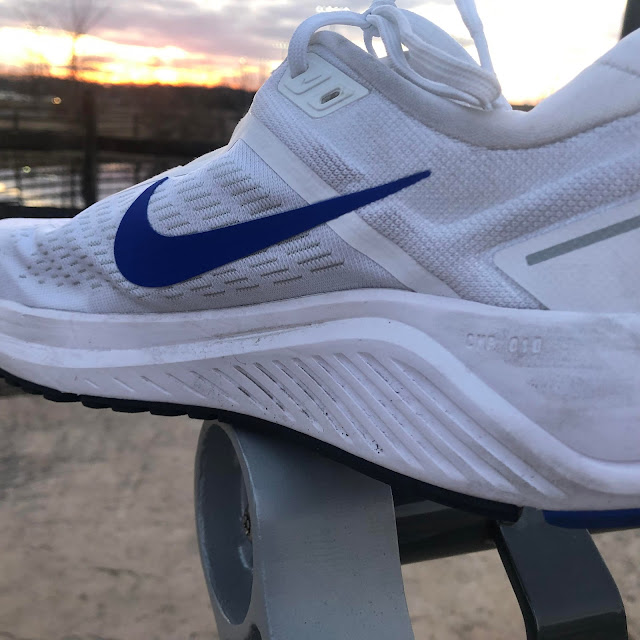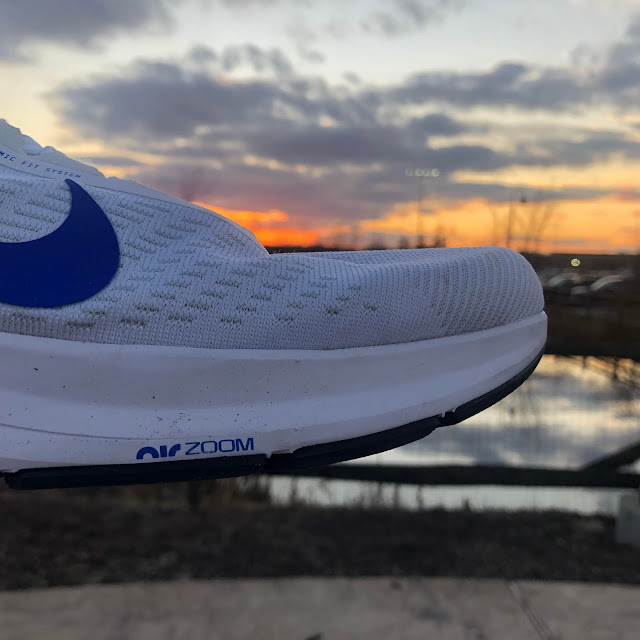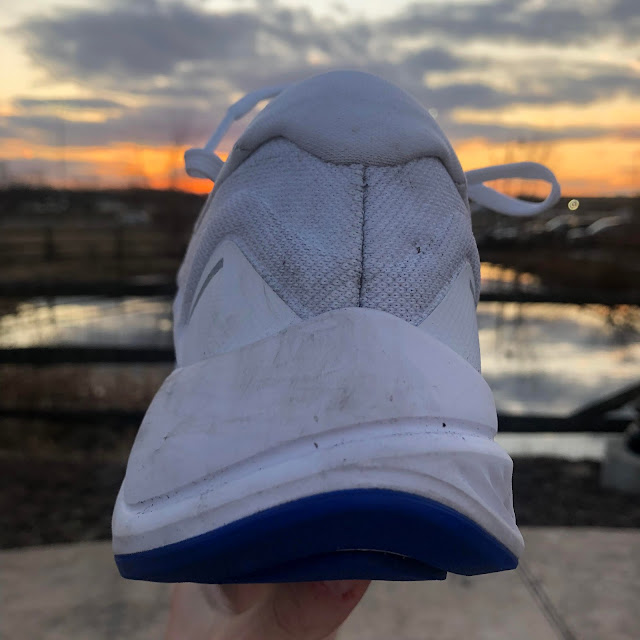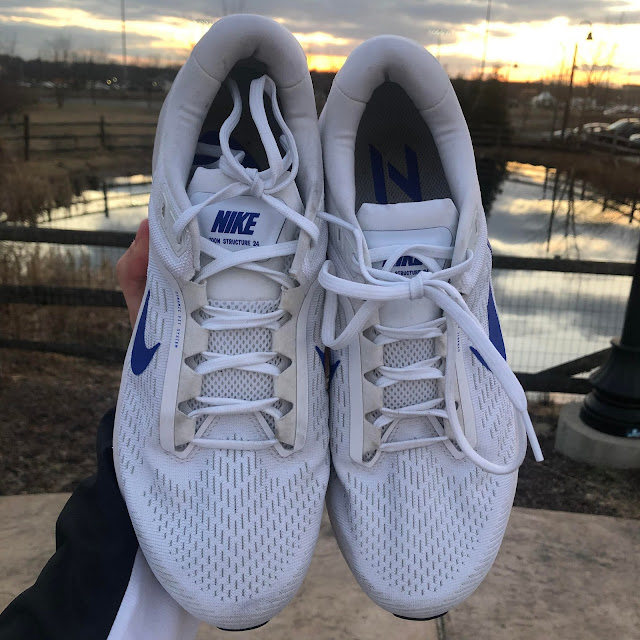Nike Air Zoom Structure 24 Review: Naturally Supportive
By Chief Editor Matthew Klein
The Nike Structure series has struggled for several years. Increasing weight, a loss of responsiveness and a general unpleasant ride made even wanting to review them difficult. Fortunately, version 23 was a departure as it was runnable, but it changed so much it was no longer listed as a stability shoe (REVIEW). Additionally, what separated version 23 from the previous issue-laden versions was that it demonstrated some progressive concepts on stability. While no medial post was present, internal geometry made for a naturally supportive ride and the firmness contributed to the stability, rather than just making the shoe feel like a brick. It was an interesting return of a shoe that some suspected to be discontinued. Version 24 has now been released and attempts to follow what worked in the previous version. An upper change is the most obvious difference between the Nike Structure 23 and 24, but inside a few things are added to make the stability more prominent than last year.
Nike Structure 24Price: $120 at Nike
Weight: 11.0 oz, 312 g (men's size 10), 9.0 oz, 256 g (women's size 8)
Stack Height: 27 mm / 18 mm
Drop: 8 mm
Classification: Stable Neutral / Mild Stability Daily Trainer
RUNNING SHOE SUMMARY
The Nike Zoom Structure 24 is a firmer, durable, mild stability daily trainer. A new slightly wider fit with a plusher upper sits up top. The sole remains firm but is slightly responsive if you land farther forward. The stability methods continue to be non-traditional but are still noticeable and provide mild stability on the medial side. Best for easy mileage and recovery runs, the Nike Zoom Structure 24 continues to make small strides forward from several disappointing versions of this long-running footwear line.
FIT
The Nike Zoom Structure 24 fits me true to size if slightly short in my normal US men's 10. The overall fit is normal with a slightly wide width and lower volume. There is a large amount of cushioning in the heel collar which initially makes the fit feel short. After a few miles, this breaks in and the upper stretches, making the shoe fits true to size. The toe box is slightly wider but the upper sits low on the foot. The provides some room for the toes to move medially/laterally, but those with higher volume feet may need to let the upper stretch (there is no wide version I am aware of). Despite the slightly wider width, I had no security issues and did not have to lace lock this shoe.
There is a stiff heel counter in the rearfoot that I did not notice at all due to the amount of cushioning around the heel counter. I caution those who are sensitive to these as I have begun to notice it slightly more as the heel collar padding breaks in. The tongue is connected directly to the upper. It is thicker and highly cushioned like the heel collar, but stays in place (mostly because it cannot move). The upper is fairly soft against the foot, but I would suggest wearing socks while running due to seams in the transition between the midfoot and heel along. Outside of that, the upper is fairly seamless, fitting comfortably against the foot and stretching well. The upper overall is a large departure from the firmer and stiff one found in version 23. The softness/plushness is extremely comfortable and contrasts with the firm sole.
PERFORMANCE
The Nike Zoom Structure 24 is a firm daily trainer. There is some mild flexibility in the forefoot and the zoom air unit upfront makes it feel slightly responsive for those who land farther forward. However, the ride is firm throughout the length of the shoe. The firmness adds to the stability but makes this shoe better for easy runs and recovery runs for those who want a firmer ride. There is an 8mm drop, which is exactly how it feels. Combined with a solid heel bevel that is slightly lateral, this makes for solid transitions for rearfoot strikers. Per Nike, there is a specially designed crash pad based on data used from hundreds of wear-testers. The transitions feel a bit slow, which adds to the stability but further emphasizes this shoe being an easy or recovery day shoe. There is a significant amount of outsole rubber and there is no wear even on my left shoe even after 55 miles. The midsole has broken in over the miles and continues to feel better the more miles I get on it. Based on this, I expect the Nike Structure 24 to last far beyond the durability of most shoes. So for those looking for an incredibly durable and firm daily trainer, the Nike Structure 24 may be worth a look.
STABILITY
The Nike Zoom Structure 24 is not listed officially as a stability shoe, but there are several noticeable methods that make this a mild stability shoe. The midsole is firmer with a slightly wider last, which adds inherent stability along the length of the shoe. There are large guidance lines in the outsole that become more apparent in the forefoot. This may provide mild guidance laterally at the forefoot. There is no official post in this shoe, but there is noticeable pressure along the medial heel and midfoot in this shoe. There is a significant crash pad that travels from the lateral heel to midfoot, which makes the lateral side feel softer than the medial side. This creates additional resistance to motion on the medial side, further contributing to the medial stability. The pressure on the medial side has remained consistent and actually increased as the midsole has broken in. For that reason, I would not classify this as a neutral shoe but instead as mild to lower end moderate stability. It provides more resistance medially along the heel and midfoot, which creates a lateral bias. Those who need resistance for medial motion may enjoy this shoe, while those who tend to go more laterally may not do well here. So despite attempting to be a more neutral shoe with new-age stability methods, the Nike Structure 24 ends up feeling like a more traditional mild stability shoe.
THOUGHTS AS A DPT / FOOTWEAR SCIENCE
The Nike Structure 24 is a continuation of Nike's newer vision of stability. However, it is similar to other companies in that it is moving away from traditional methods like posts. There is nothing wrong with using a post but not everyone responds the same way to them. In this case, instead of bulking up the medial side, Nike has done the opposite by creating a more collapsable lateral side. Nike boasts that "It helps provide extra cushioning for heel-to-toe transitions, supporting runners that tend to overpronate." David's favorite phrase is "Crash Pad" so let's dive into what this is and what it does.
A crash pad is a segmented part of the midsole at the posterior lateral corner of the shoe. It is usually softer or designed differently section from the rest of the shoe to facilitate the normal initial contact of the heel at the posterior lateral aspect of the shoe and transition forward. A variety of claims have been made about crash pads, including that they help control pronation or provide extra cushioning like Nike does above. Initial evidence by Heidenfelder et al. (2010) over a decade ago suggested that specifically designed crash pads could decrease variables associated with impact. In other words, they postulated that this design could reduce impact forces during heel strike. However, one short year later a paper by Shorten & Mientjes (2011) and several others challenged whether traditional variables like impact peaks were even valid measures of impact forces. Heel impact peaks are the peaks seen in vertical forces that occur with heel strike type running gait. This was thought to be a major influence and risk factor for injury, hence part of the belief that heel striking was bad. Current evidence has shown there is no significant different injury rates between heel and forefoot initial contacts, but the injury types are different (Andreson et al., 2017). What Shorten and Mientejes (2011) and others challenge was that the peak seen in the vertical plane was even lining up with the true initial contact and that it did not factor in the many variables associated with impact, including horizontal impact forces and others. Further discussion would challenge that the measurement doesn't accurately assess what is happening within the body, hence further research suggesting that excessive shoe cushioning may actually increase internal joint loading rather than decreasing it (Kulmala et al., 2018).
Based on the above evidence, it would seem that crash pads do not significantly influence impact forces related to cushioning properties. They do however seem to influence the angle of foot contact and rearfoot stability. A study several years later by Sterzing et al., (2015) tested this again and found that crash pads do not significantly affect cushioning or perceived cushioning. It did seem to influence initial contact angle and rearfoot stability, specifically with the lateral placement guiding the foot more in that direction rather than medially (Sterzing et al., 2015). Motion usually goes through the path of least resistance. A crash pad is a softer section that often collapses more than the medial section. This is seen in a variety of ways now, including being built into the sole like the Nike Structure 24 or having a split heel design where the lateral side compresses independently as seen in shoes like the recent Saucony Kinvaras. This collapse of the lateral side will cause the foot to stay on the lateral side of the shoe as it progresses forward through the gait cycle. The medial side does not collapse at the same rate, potentially providing resistance to medial motion. This will work great as a way to guide rearfoot strikers who need medial stability, but not those who need lateral stability. Those who need lateral stability shoe look for stability shoe with lateral guiderails or sidewalls, which are becoming far more popular. So at least half of Nike's claim may hold true, as their crash pad design may help with those who tend to need some help controlling medial motion during the initial contact and loading response phases of gait (there is no set definition still of what "overpronation" is). The cushioning property comment though is not as valid, as the rearfoot is still extremely firm in the Nike Structure 24.
References
Anderson, L., Barton, C., & Bonanno, D. (2017). The effect of foot strike pattern during running on biomechanics, injury and performance: A systematic review and meta-analysis. Journal of Science and Medicine in Sport, 20, e54.
Heidenfelder, J., Sterzing, T., & Milani, T. L. (2010). Systematically modified crash-pad reduces impact shock in running shoes. Footwear Science, 2(2), 85-91.
Kulmala, J. P., Kosonen, J., Nurminen, J., & Avela, J. (2018). Running in highly cushioned shoes increases leg stiffness and amplifies impact loading. Scientific Reports, 8(1), 1-7.
Shorten, M., & Mientjes, M. I. (2011). The ‘heel impact’force peak during running is neither ‘heel’nor ‘impact’and does not quantify shoe cushioning effects. Footwear Science, 3(1), 41-58.
Sterzing, T., Thomsen, K., Ding, R., & Cheung, J. T. M. (2015). Running shoe crash-pad design alters shoe touchdown angles and ankle stability parameters during heel–toe running. Footwear Science, 7(2), 81-93.
RECOMMENDATIONS
The Nike Structure 24 is a unique offering as a firmer and durable shoe in an industry that is getting softer and short-lasting. My major suggestion is to continue to delineate this as a stability shoe given the amount of lateral bias from the medial resistance being so noticeable. My other suggestion would be to consider lightening the shoe up. Although my size 10 weighs in at 10.8 oz, which is slightly lighter than the 23, it still feels a little clunky. Part of this may be the fact this shoe needs time to break in (which is rare for footwear in today's world) but for a ride so firm I would expect this shoe to be lighter. While the firmness does add inherent natural stability, it may turn people away from this shoe upon initial try-on. So I would suggest softening the ride just a bit. Not enough to take away from the inherent stability, but enough to make it a little easier to transition into it.
WHO THIS SHOE IS FOR
The Nike Zoom Structure 24 is for those who want a firm, mild to moderate stability shoe with a slightly wider fitting upper. The upper is the primary update from version 23, featuring a more comfortable and plush fit with additional cushioning in the heel. The ride is firm throughout and is better for easy/recovery runs due to the heavier and less responsive nature. Although not listed as a stability shoe, there is a solid amount of pressure along the medial side of the shoe. This provides mild to moderate stability for those wanting it in a firmer riding shoe. Overall, the Nike Structure 24 provides more medial resistance than the previous version, returning to its roots while still being a different shoe.
GRADING
Matt
Fit: A- (slightly wider fit, particularly in the toebox, but remains secure. Comfortable, well-padded upper)
Performance: B- (Firmer ride that feels heavier than the listed weight, ie a bit clunky. Solid bevel and transition, but best for recovery and easy runs. Better for those who land farther forward and does break in with time)
Stability: A- [Stable Neutral But Really Mild/Moderate Stability] (Noticeable medial resistance from long lateral crash pad, firmer ride and lateral guidance lines)
DPT/Footwear Science: B+ (Solid stability design, but some claims regarding cushioning that are not supported by evidence and feel of the rearfoot midsole)
Personal: B/B+ (Provides solid stability that works well with my feet and improves as the shoe breaks in, but feels heavier than I would like)
Overall: B+ (A unique firm ride in today's soft world for those who need a little more room and medial mild stability without posting)
SHOP | SUPPORT DOR
Using the following links to purchase helps support Doctors of Running. Thanks so much!
Check out Gear We Love
New Balance Rebel v2: One of the most fun trainers of 2021 so far
Asics Metaspeed Sky: Chief Editor Matt Klein can't stop racing in it, even on trails (not advised)
Feetures Socks: Massively grippy socks that will make you feel more one with the shoe
Ultraspire Fitted Race Belt: The best way to carry your phone and goods on the run. No bounce and various sizes for waist
Skratch Recovery, Coffee Flavor: Mental and physical boost post run. Coffee flavor is excellent and goes great straight into a fresh brewed cup
Trigger Point Foam Roller: Help get those knots out post-run and feel better for tomorrow
Theragun Massager: This small version is great on the go for working tired legs
Ciele Hat: Our team's favorite running hat of choice!
FURTHER READING
Craft CTM Ultra Carbon 2 Review - The plated sibling to the Ultra 2
Saucony Kinvara 13 - A fantastic new upper highlights the latest Kinvara update
Craft CTM Carbon Race Rebel - Powered by the light UD Foam Pro and a plate
Saucony Peregrine 12 - A lighter, yet more protective update to the trail runner
Hoka Speedgoat 5 - A well-refined update to a great trail series from Hoka
Find all Shoe Reviews at Doctors of Running here.
Thanks for reading!
FOLLOW DOCTORS OF RUNNING ON SOCIAL MEDIA
Facebook: Doctors of Running
Youtube Channel: Doctors of Running
Instagram: @doctorsofrunning
LinkedIn: Doctors of Running
Strava: Doctors of Running
Podcast: Virtual Roundtable
Pinterest: Doctors of Running
TESTER PROFILES:
Matthew Klein, PT DPT PhD(c) OCS FAAOMPT
Editor's Note: As always, the views presented on this website belong to myself or the selected few who contribute to these posts. This website should not and does not serve as a replacement for seeking medical care. If you are currently injured or concerned about an injury, please see your local running physical therapist. If you are in the Los Angeles area, I am currently taking clients for running evaluations.
Contact us at doctorsofrunning@gmail.com
NEXT: Saucony Kinvara 13 Review











